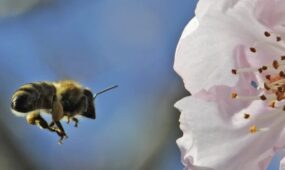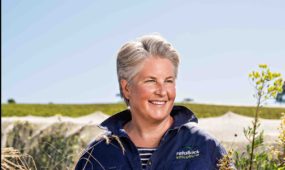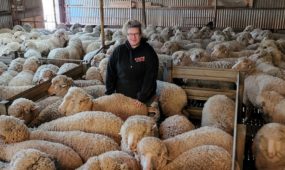The New World: reaching out to untouched alpaca markets
Primary Industries
It might seem odd to think that there are places where people have never seen or even heard of alpacas – but that’s exactly the case when Matthew Lloyd of EP Cambridge Stud in South Australia travels to the far ends of the camelid world.

Sign up to receive notifications about new stories in this category.
Thank you for subscribing to story notifications.
“I still go to judge alpacas in Eastern Germany and around Europe, and they don't know what the hell they are – they've never seen them before. All these little countries don't know what they are,” explains Lloyd.
Matthew and Cathy Lloyd run EP Cambridge Stud, a herd of about 3500 animals split between their property in South Australia and one in the United Kingdom.
“We've been exporting for 13 years. The first real market was New Zealand, but since then we've supplied China and most European countries like Ireland, France, Spain, Germany and of course the UK.”
They started out in the mid-90s with six females, growing their herd over time to about 100 before bringing in a couple of big Peruvian imports that saw the number rise to 550.
Their stud is now one of the largest in the world, and their bloodlines dominate most of the shows around Europe and Australia.
It wasn't easy, and Matthew, who was an accountant by trade, admits he was pretty clueless when they started out. In fact, he bought a turf farm with the idea of planting a vineyard – but the lack of topsoil meant they went with alpacas instead.
“It's been a steep learning curve. Twenty years ago there was no book to decide what constituted a good alpaca. Eventually we'd been to enough Royal Agricultural Shows in Adelaide and got our hands over the reigning merino sheep champion enough times to know what made good fleece.”
He's quietly spoken and reserved, which belies the extreme success that they've had. Their stud is now one of the largest in the world, and their bloodlines dominate most of the shows around Europe and Australia.
One of their champion males, Invictus, was sold for $175,000 last year to a New Zealand breeder.
For the last seven years the UK has been their biggest market, which prompted them to move there and establish the second branch of their stud.
It's both beneficial and challenging; with five children under the age of 15 trailing behind them, well over 2000 alpacas in South Australia and 800 in the UK, the logistics are frightening.
But there are benefits too – a direct link to the European market, and being counter-seasonal, they can spend the entire year judging.
“We judge in most European countries with alpacas, which is great for us because we get to see how their stock and quality is developing,” Lloyd says.
One of the most interesting markets that Cambridge Stud is exploring is in China – and it has the potential to be huge.
“Six years ago we sold 50 to a university there. That was effectively the Chinese government as our customer. They were doing a seven year feasibility study, really doing their homework with the view to come to a conclusion whether that might be an industry for China and Inner Mongolia,” Lloyd says.
“If you see some of the books they've put out, it's really very impressive. My understanding is that the study has come up with lots of green lights – and now the mainstream protocols are being worked on.”
He's assuming that shortly they'll be gearing up imports – but the problem might be how many alpacas the industry here can provide. Pricing is an issue too.
“They've given a standard criteria on what sort of animals they're looking for, a certain age, micron and colour range. Their buy price is probably one to two thousand dollars where the breeders will be expecting three to four.
“We've been quoted numbers from agents in China, for two to three thousand head – they're not going to be able to fill those orders anyway, whether it's two thousand dollars a head or four thousands. Not in a hurry anyway.”
Chris Williams from Ambersun Alpacas is another breeder with experience selling alpaca product to China, albeit in the form of fleece.
“The problem is they want one tonne of this, or two tonnes of that. Even with 1200 hundred animals we struggle to supply what they want. Yes, I can supply them this year because I have a stockpile of a couple of years, but once they take that, I'm under the pump,” Williams explains.
That's perhaps one of the biggest hurdles of alpaca fleece becoming mainstream; having the critical mass to meet its growing demand.
Chris Williams and his wife Adrienne Clarke from Ambersun, also based in South Australia, got their start in the early 90s.
“My wife saw Alpacas in the children's nursery at the Royal Adelaide Show and fell in love with them. We bought our first animals which ranged in price from $20-30,000, which was just insane, but we borrowed enough to get started,” Williams says.
Shortly after they started Alpaca Classica, an alpaca-fleece fashion label, and Williams spent the following years touring the country's other herds with a top stud male. It was a good business plan until the GFC hit.
Another opportunity arose while Williams was visiting some alpaca shows in Europe. A shearer there had put his shoulder out, so he volunteered to take over.
“What people have got to realise is that it's the same as exporting in to Europe – there's no room for low quality animals.”
“I rang my wife and said, 'put my hair pieces and my shearing gear in a box and send it over!' I've been doing that ever since, shearing about 2000 alpacas a year in Europe. This opened the door to enable us to export the animals in to Europe.”
Rather than set up a separate branch of their stud like EP Cambridge, Ambersun uses an agent to sell their animals. Williams provides an additional service in running seminars and shearing the animals.
“We do workshops and teach people about fibre and the industry. It doesn't matter if they simply want to be involved in the pet industry, the showring industry or commercialised as we are with fleece and meat. We try and give people the opportunity to totally emulate what we're doing.
“I leave my wife at home with 1200 alpacas, three kids, one horse and three dogs and off I go for three months of the year.”
Williams is involved in the export in to Turkey. Much like China, it's a market very much in its infancy. Government supported programs are being run by the university to determine whether alpacas are suitable for the country.
Once the protocols are drawn up, it could be another massive market for quality alpacas – and quality alpaca fleece – from around the world. Turkey is one of the world's leading exporters of textiles. It's their biggest industry with over 35,000 companies working in the space.
“Is that going to be a market that will open up for everyone? It's too early to say, just like China. What people have got to realise is that it's the same as exporting in to Europe – there's no room for low quality animals.
“Everyone has access to the internet, everyone can see the good looking animals. Why do I want to buy the old rubbishy ones? There's so much more information available than when we started.”
“We've got that genetic depth. China could buy from Peru… but they're not necessarily going to get that known parentage.”
Unfortunately, Williams says, there are people still breeding the same animals that they bought 20 years ago, and that doesn't cut it when you're selling to a global market with very high expectations.
“You bought a brand new car 20 years ago. It was probably very nice to drive when you bought it – but do you still want to be driving that car today, or do you want to go out and buy the latest new model?”
Matthew Lloyd of EP Cambridge Stud has acknowledged the shift in standards too. Whereas South America used to lead the way in exporting animals, countries like Australia and America have refined the genetics to a point where they're far ahead of the pack.
“We've got that genetic depth. China could buy from Peru, where arguably they'll be able to import the alpacas cheaper, but they're not necessarily going to get that known parentage,” Lloyd says.
“They can come here and they can buy an alpaca they know has four or five generations of pedigree. In South America – it's improved significantly since I was there – but you never know what you're getting. The mother could be a black and grey and the father could be a Suri cross or something. It was a chocolate box – you had to get a bit lucky.”
It's these qualities that will set the successful exporters apart: known parentage and genetic depth on top of the quality of the fleece – and perhaps the numbers to make up the supply that these broad new markets will demand.
In countries like China, bio-security is a huge concern too. South America has foot and mouth disease still, and Australia doesn't – another advantage.
There are barriers facing exports still. Coming out of Australia, animals have to be quarantined in New Zealand for a time, something that can take some of the steam out of the exporter's engines.
The only solution is to make it easy as possible for customers to by them directly from breeders – something often left to governing bodies and foreign affairs pacts.
But, for all the issues, and all the uncertainty that can surround new markets, Lloyd is confident that the industry is in a good place to meet any challenges that come along.
“If you look at pure performance in shows over the last few years now, arguably the most success has been centred in South Australia over a lot of studs. We're sitting in a pretty preeminent position in the whole global alpaca world really. Of course I'm biased,” Lloyd laughs.
“Even after 20 odd years, certainly exporting for over 10, there are still so many countries to explore. Look at the whole eastern bloc of Russia – I think the marketing opportunities there over the next ten or twenty years are vast.”
This story first appeared in Alpaca Culture magazine's December 2014 issue.
Jump to next article



